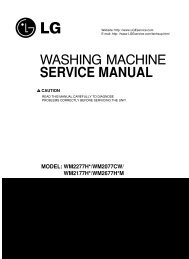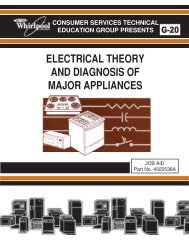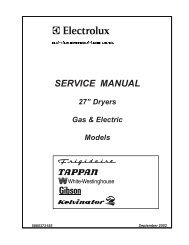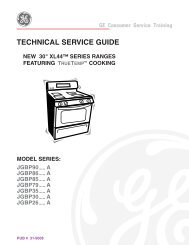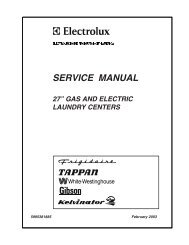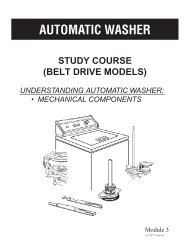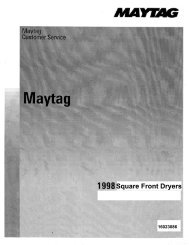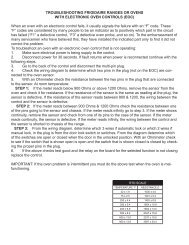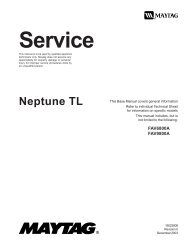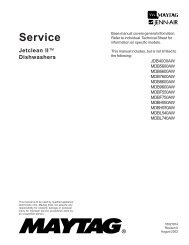MFI2568AES Service Manual - Appliance 911 Sea Breeze
MFI2568AES Service Manual - Appliance 911 Sea Breeze
MFI2568AES Service Manual - Appliance 911 Sea Breeze
You also want an ePaper? Increase the reach of your titles
YUMPU automatically turns print PDFs into web optimized ePapers that Google loves.
Component Testing<br />
! WARNING<br />
To avoid risk of electrical shock, personal injury, or death, disconnect electrical power source to unit, unless test<br />
procedures require power to be connected. Discharge capacitor through a resistor before attempting to service.<br />
Ensure all ground wires are connected before certifying unit as repaired and/or operational.<br />
Component Description Test Procedures<br />
Capacitor Run capacitor connects to relay terminal<br />
3 and L side of line.<br />
Some compressors do not require a run<br />
capacitor; refer to the Technical Data<br />
Sheet for the unit being serviced.<br />
!<br />
WARNING<br />
To avoid electrical shock which can cause severe personal injury or death,<br />
discharge capacitor through a resistor before handling.<br />
1. Disconnect power to refrigerator.<br />
2. Remove capacitor cover and disconnect capacitor wires.<br />
3. Discharge capacitor by shorting across terminals with a resistor for 1 minute.<br />
4. Check resistance across capacitor terminals with ohmmeter set on “X1K”<br />
scale.<br />
• Good—needle swings to 0 ohms and slowly moves back to infinity.<br />
• Open—needle does not move. Replace capacitor.<br />
• Shorted—needle moves to zero and stays. Replace capacitor.<br />
• High resistance leak—needle jumps toward 0 and then moves back to<br />
constant high resistance (not infinity).<br />
Condenser<br />
Condenser is a tube and wire<br />
construction located in machine<br />
compartment.<br />
Leaks in condenser can usually be detected by using an electronic leak detector<br />
or soap solution. Look for signs of compressor oil when checking for leaks. A<br />
certain amount of compressor oil is circulated with refrigerant.<br />
Condenser is on high pressure discharge<br />
side of compressor. Condenser function<br />
is to transfer heat absorbed by refrigerant<br />
to ambient.<br />
Higher pressure gas is routed to<br />
condenser where, as gas temperature is<br />
reduced, gas condenses into a high<br />
pressure liquid state. Heat transfer takes<br />
place because discharged gas is at a<br />
higher temperature than air that is<br />
passing over condenser. It is very<br />
important that adequate air flow over<br />
condenser is maintained.<br />
Condenser is air cooled by condenser fan<br />
motor. If efficiency of heat transfer from<br />
condenser to surrounding air is impaired,<br />
condensing temperature becomes higher.<br />
High liquid temperature means liquid will<br />
not remove as much heat during boiling<br />
in evaporator as under normal conditions.<br />
This would be indicated by higher than<br />
normal head pressures, long run time,<br />
and high wattage. Remove any lint or<br />
other accumulation, that would restrict<br />
normal air movement through condenser.<br />
From condenser the refrigerant flows into<br />
a post condenser loop which helps<br />
control exterior condensation on flange,<br />
center mullion, and around freezer door.<br />
Refrigerant flows through the drier to<br />
evaporator and into compressor through<br />
suction line.<br />
Leaks in post condenser loop are rare because loop is a one-piece copper tube.<br />
For minute leaks<br />
1. Separate condenser from rest of refrigeration system and pressurize<br />
condenser up to a maximum of 235 PSI with a refrigerant and dry nitrogen<br />
combination.<br />
2. Recheck for leaks.<br />
!<br />
WARNING<br />
To avoid severe personal injury or death from sudden eruption of high<br />
pressures gases, observe the following:<br />
Protect against a sudden eruption if high pressures are required for leak<br />
checking.<br />
Do not use high pressure compressed gases in refrigeration systems<br />
without a reliable pressure regulator and pressure relief valve in the<br />
lines.<br />
6 16026312 ©2006 Maytag <strong>Service</strong>s



